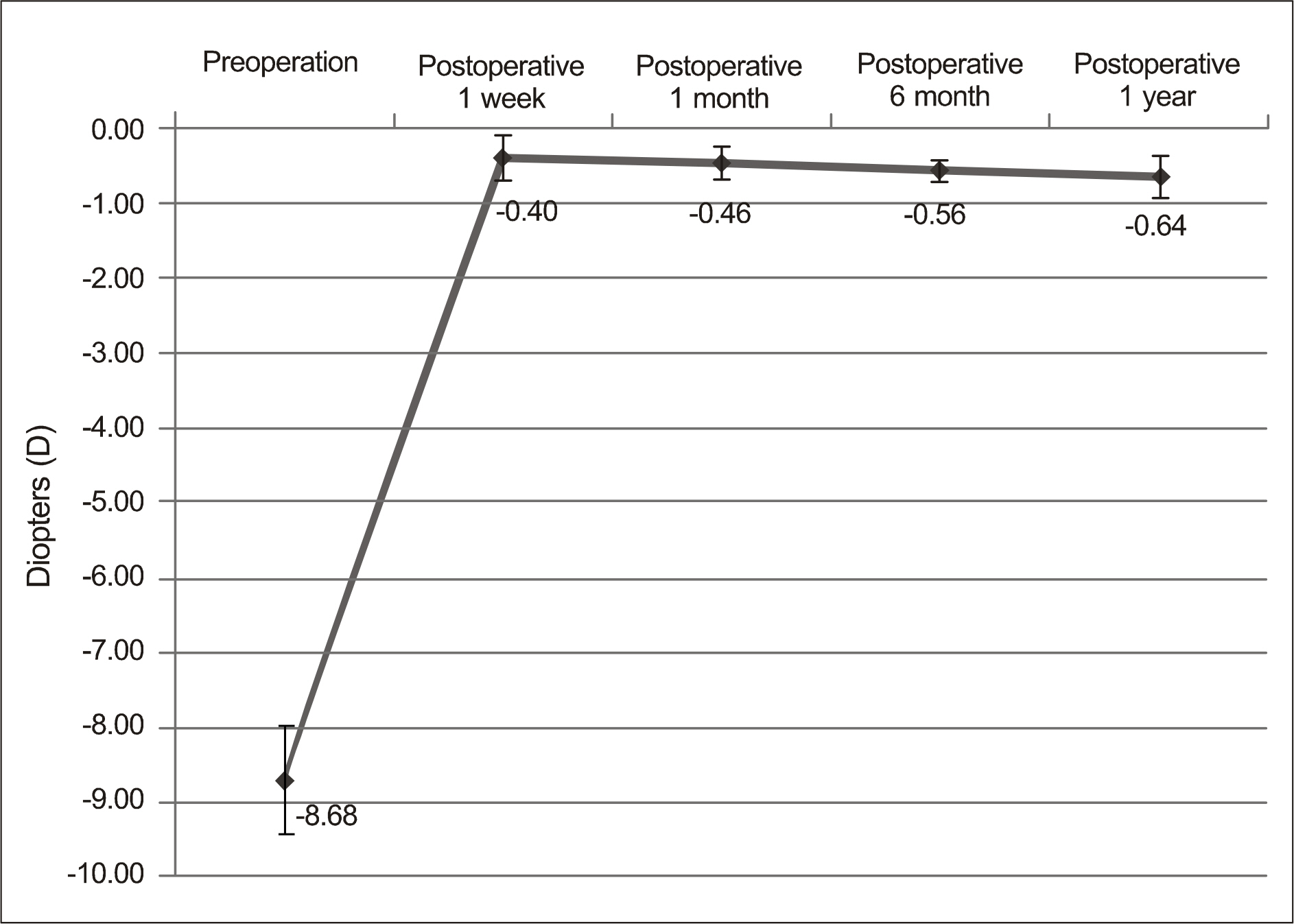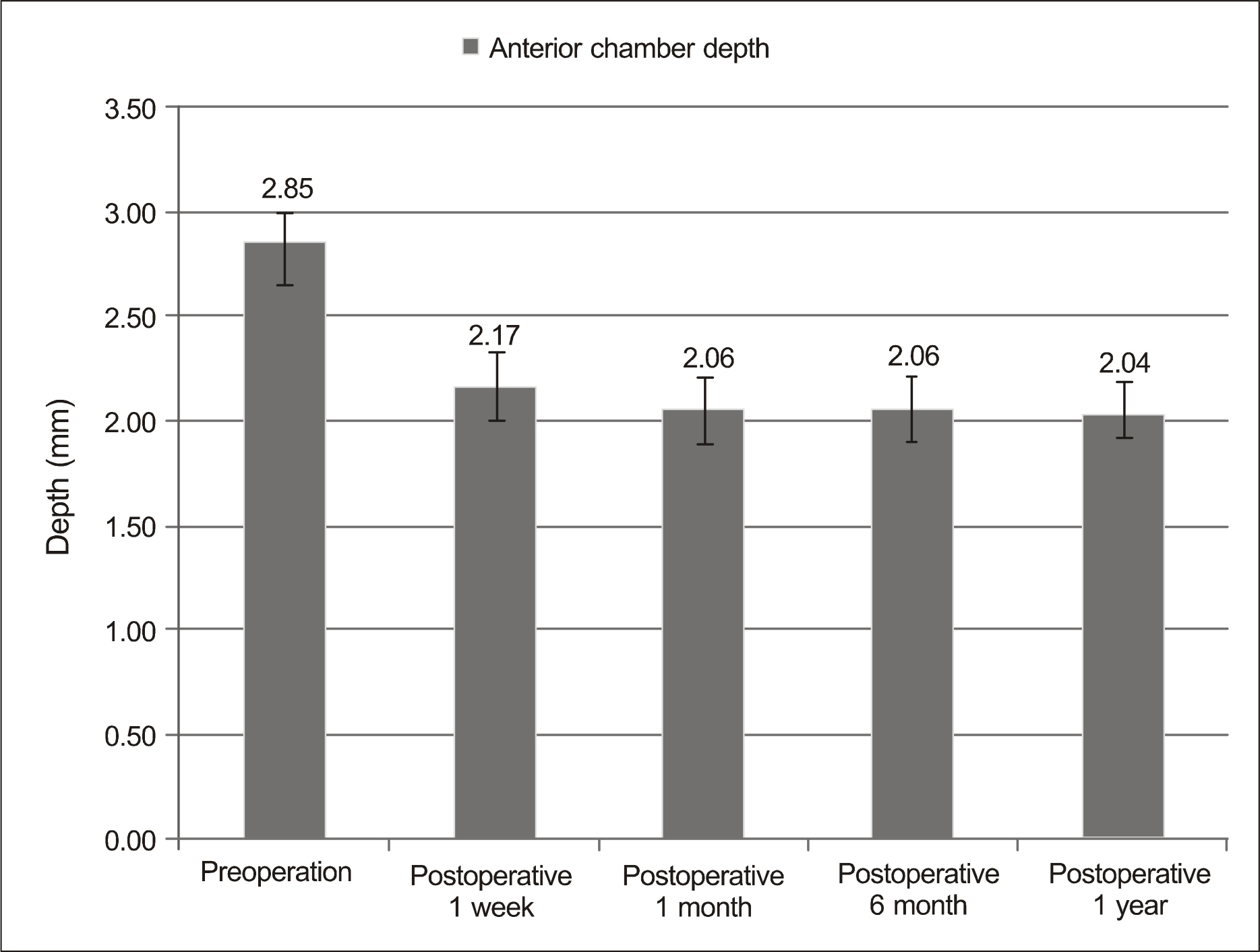J Korean Ophthalmol Soc.
2011 Feb;52(2):157-162.
Long-Term Changes in Tilt, Decentration and Anterior Chamber Depth After Implantable Collamer Lens Insertion
- Affiliations
-
- 1Department of Ophthalmology and Visual Science, The Catholic University of Korea School of Medicine, Seoul, Korea. eyedoc@catholic.ac.kr
Abstract
- PURPOSE
To evaluate the stability of implantable collamer lens (ICL, Staar Surgical AG, Niau, Switzerland) by comparing changes of tilt, decentration and anteroir chamber depth after ICL implantation during 1 year.
METHODS
The results of 8 high myopic patients (16 eyes) that had received ICL implantation were retrospectively studied. Tilt and decentration of ICL were measured using an anterior eye segment analysis system (Scheimpflug camera, EAS-1000, Nidek, Japan). Anterior chamber depth was measured in both eyes preoperatively and postoperatively by Scheimpflug camera. The follow-up period was 1 year.
RESULTS
Tilt was 1.90 +/- 1.23degrees, 1.75 +/- 0.80degrees, 1.64 +/- 0.86degrees, 2.08 +/- 1.33degrees (p = 0.36) and decentration were 0.04 +/- 0.01 mm, 0.03 +/- 0.01 mm, 0.03 +/- 0.02 mm, 0.04 +/- 0.02 mm (p = 0.59) at 1 week, 1 month, 6 months and 1 year respectively. Tilt and decentration showed no significant change after ICL implantation. The average anterior chamber depth was 2.85 +/- 0.26 mm preoperatively, and 2.17 +/- 0.39 mm, 2.06 +/- 0.31 mm, 2.06 +/- 0.34 mm, 2.04 +/- 0.35 mm at 1 week, 1 month, 6 months and 1 year respectively. Anterior chamber depth became narrow after ICL implantation (p = 0.02), but showed no significant narrowing postoperatively (p = 0.08).
CONCLUSIONS
The IOL position remained stable, with no significant changes for an extended period of tilt, decentration, or anterior chamber depth after ICL implantation.
Figure
Reference
-
References
1. Marcos S. Aberrations and visual performance following standard laser vision correction. J Refract Surg. 2001; 17:S596–601.
Article2. Fyodorov SN, Zuyev VK, Aznabayev BM. Intraocular correction of high myopia with negative posterior chamber lens. Ophthal- mosurgery. 1991; 3:57–8.3. Sanders DR, Vukich JA; ICL in Treatment of Myopia (ITM) Study Group. Incidence of lens opacities and clinically significant cataracts with the implantable contact lens: comparison of two lens designs. J Refract Surg. 2002; 18:673–82.4. Gonvers M, Othenin-Girard P, Bornet C, Sickenberg M. Implantable contact lens for moderate to high myopia: short-term followup of 2 models. J Cataract Refract Surg. 2001; 27:380–8.5. Dejaco-Ruhswurm I, Scholz U, Pieh S, et al. Long-term endothelial changes in phakic eyes with posterior chamber intraocular lenses. J Cataract Refract Surg. 2002; 28:1589–93.
Article6. Edelhauser HF, Sanders DR, Azar R, et al. Corneal endothelial assessment after ICL implantation. J Cataract Refract Surg. 2004; 30:576–83.
Article7. Risco JM, Cameron JA. Dislocation of a phakic intraocular lens. Am J Ophthalmol. 1994; 118:666–7.
Article8. Ibrahim O, Waring GO 3rd. Successful exchange of dislocated phakic intraocular lens. J Refract Surg. 1995; 11:282–3.9. Alió JL, de la Hoz F, Pérez-Santonja JJ, et al. Phakic anterior chamber lenses for the correction of myopia: a 7-year cumulative analysis of complications in 263 cases. Ophthalmology. 1999; 106:458–66.10. Budo C, Hessloehl JC, Izak M, et al. Multicenter study of the Artisan phakic intraocular lens. J Cataract Refract Surg. 2000; 26:1163–71.
Article11. Pérez-Santonja JJ, Bueno JL, Zato MA. Surgical correction of high myopia in phakic eyes with Worst-Fechner myopia intraocular lenses. J Refract Surg. 1997; 13:268–81.
Article12. Wiechens B, Winter M, Haigis W, et al. Bilateral cataract after phakic posterior chamber top hat-style silicone intraocular lens. J Refract Surg. 1997; 13:392–7.
Article13. Khan AJ, Percival SP. 12 year results of a prospective trial comparing poly(methyl methacrylate) and poly (hydroxyethyl methacrylate) intraocular lenses. J Cataract Refract Surg. 1999; 25:1404–7.14. Rosen E, Gore C. Staar Collamer posterior chamber phakic intraocular lens to correct myopia and hyperopia. J Cataract Refract Surg. 1998; 24:596–606.
Article15. Zaldivar R, Davidorf JM, Oscherow S. Posterior chamber phakic intraocular lens for myopia of −8 to −19 diopters. J Refract Surg. 1998; 14:294–305.
Article16. Zaldivar R, Oscherow S, Ricur G. The STAAR posterior chamber phakic intraocular lens. Int Ophthalmol Clin. 2000; 40:237–44.
Article17. Sanders DR, Brown DC, Martin RG, et al. Implantable contact lens for moderate to high myopia: phase 1 FDA clinical study with 6 months followup. J Cataract Refract Surg. 1998; 24:607–11.18. Sarver EJ, Sanders DR, Vukich JA. Image quality in myopic eyes corrected with laser in situ keratomileusis and phakic intraocular lens. J Refract Surg. 2003; 19:397–404.
Article19. Sanders DR, Vukich JA, Doney K, Gaston M. U.S. Food and Drug Administration clinical trial of the implantable contact lens for moderate to high myopia. Ophthalmology. 2003; 110:255–66.
Article20. Uusitalo RJ, Aine E, Sen NH, Laatikainen L. Implantable contact lens for high myopia. J Cataract Refract Surg. 2002; 28:29–36.
Article21. Han SY, Lee KH. Long term effect of ICL implantation to treat high myopia. J Korean Ophthalmol Soc. 2007; 48:465–72.22. Gonvers M, Bornet C, Othenin-Girard P. Implantable contact lens for moderate to high myopia: relationship of vaulting to cataract formation. J Cataract Refract Surg. 2003; 29:918–24.23. Kwon SM, Oh HC, Lee DJ, et al. Comparison of anterior segment parameters in angle-closure glaucoma using Scheimpflug camera. J Korean Ophthalmol Soc. 2009; 50:128–34.24. Catalano RA, Kassoff A. Irreversible intraocular lens vaulting with pupillary-block glaucoma. Am J Ophthalmol. 1986; 101:735–6.
Article25. Kamiya K, Shimizu K, Komatsu M. Factors affecting vaulting after implantable collamer lens implantation. J Refract Surg. 2009; 25:259–64.
Article26. Kojima T, Maeda M, Yoshida Y, et al. Posterior chamber phakic implantable collamer lens: changes in vault during 1 year. J Refract Surg. 2010; 26:327–32.
Article27. Kamiya K, Shimizu K, Kawamorita T. Changes in vaulting and the effect on refraction after phakic posterior chamber intraocular lens implantation. J Cataract Refract Surg. 2009; 35:1582–6.
Article28. Chun YS, Lee JH, Lee JM, Park IK. IOP and gonioscopic changes after implantable contract lens implantation in myopic eyes. J Korean Ophthalmol Soc. 2005; 46:336–44.29. Sasaki K, Sakamoto Y, Shibata T, et al. Measurement of postoperative intraocular lens tilting and decentration using Scheimpflug images. J Cataract Refract Surg. 1989; 15:454–7.
Article30. Baumeister M, Neidhardt B, Strobel J, Kohnen T. Tilt and decentration of three-piece foldable high-refractive silicone and hydrophobic acrylic intraocular lenses with 6-mm optics in an intra-individual comparison. Am J Ophthalmol. 2005; 140:1051–8.
Article
- Full Text Links
- Actions
-
Cited
- CITED
-
- Close
- Share
- Similar articles
-
- Decentration, Tilt and Anterior Chamber Depth: Aspheric vs Spheric Acrylic Intraocular Lens
- Diurnal Variation in the Depth of the Anterior Chamber and Correlation between the Depth of the Anterior Chamber and Intraocular Pressure
- The Relationship of the Lens Density with the Lens Thickness and the Anterior Chamber Depth
- Comparison of the Stability Between Three-piece and Single-piece Aspheric Intraocular Lenses
- Comparison of Decentration and Tilt of Sensar(R) with Acrysof




